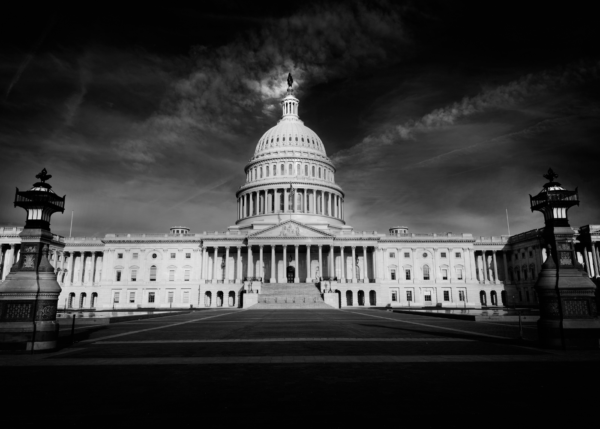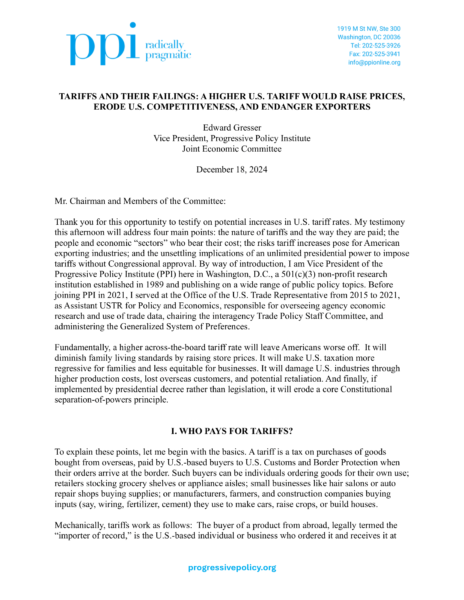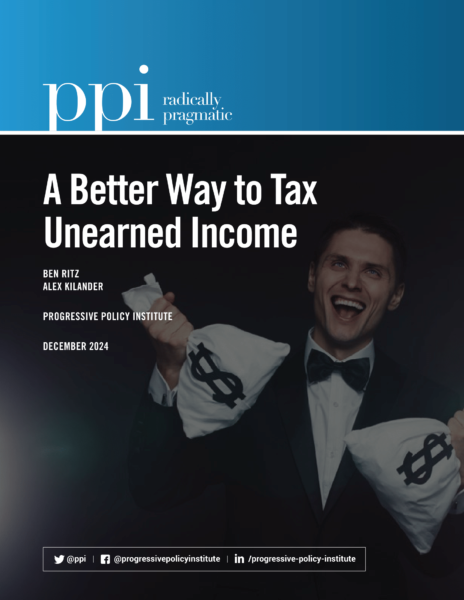FACT: U.S. tariffs are taxes paid by Americans.
THE NUMBERS: Spending on goods by American household type* –
| Household type |
Post-tax income |
Share of income spent on goods** |
| Top “decile” |
$271,600 |
18.9% |
| Average for all households |
$87,900 |
28.6% |
| Single parent |
$52,500 |
38.9% |
WHAT THEY MEAN:
Live at 2:30 p.m.: PPI’s Ed Gresser testifies this afternoon at Congress’ Joint Economic Committee on potential of higher U.S. tariffs as proposed by the Trump/Vance campaign last fall. The hearing kicks off in half an hour. In the interim, here are the four main points: a higher tariff rate means higher prices, damaged industrial competitiveness, multiple harms for U.S. exporters, and — depending on the method — can mean some systemic risk of corruption and damage to American governance.
A brief explanation of tariffs first, since recently — as the testimony observes — over the past year we’ve had “some puzzling assertions that foreigners might somehow pay tariffs. No: U.S. tariffs are taxes paid by Americans.” The basics:
A tariff is a tax on goods bought from overseas, paid to Customs and Border Protection by the U.S.-based individual or business receiving those goods at the border. For retailers, the tariff becomes part of the store price; for manufacturers, construction firms, or farmers, part of the production cost. Consider, for example, a retailer ordering a container of 10,000 men’s cotton shirts, hypothetically valued at $10 each. These have an “MFN” tariff of 19.7%, set out in line 61051000 of the U.S. Harmonized Tariff Schedule. So the retailer writes three checks:
$100,000 to the source for the shirts
$19,700 to CBP for the tariff
$5,000 to a shipping company for carrying the container.
These together make up her “landed cost” of $124,700 — i.e., the base expenditure from which she marks up to cover her domestic transport, wage and salary, and other costs, and earn enough per shirt to profit. So the shirts have cost her $12.47 each, including $1.97 in tariff payment. A week later at the cash register, the price includes this embedded tariff, amplified by markup and sales tax. The retailer has written the check; the shopper has borne the cost. Again, U.S. tariffs are taxes paid by Americans.
Now the main points. What we raise the U.S. tariff rate — 2.4% last year — to 10% or 20%? Three economic results, and perhaps (depending on the method) something more.
First: Prices rise for families as we add 10%, or 20% (or whatever the number might be), to the current tariff system’s taxation of shirts, winter vegetables, energy, OTC medicines, and so on. A series of studies earlier this year — including from Erica York of the Tax Foundation and Brendan Duke of the Center for American Progress, both also appearing at this afternoon’s hearing — suggest that a 10% tariff plus a higher rate on Chinese-made goods would cost families $2,200 to $6,000 a year. That’s a jump of at least 10% from the $25,150 the Bureau of Labor Statistics found average families spending on goods last year.* The costs of this type of tax increase fall most heavily on low-income families and least heavily on wealthy families — naturally, since lower-income households spend more of their income than average buying goods, and top-end households less. The numbers from BLS: in 2023, single-parent families spent 38.6% of their modest $52,500 post-tax income buying food, clothes, cars, furniture, toasters, etc.. This is twice the 18.9% top-decile households (with $271,600 in post-tax income) spent on goods; the national average, 28.6%, is exactly in the middle.
Second: Goods-using parts of the U.S. economy — retail, manufacturing, agriculture, construction, restaurants — decline relative to non-goods users. This is because, all else equal, if you tax one part of the economy but not another, the taxed part gets smaller. (In relative terms, not necessarily in total.) As tariffs on energy, metals, paint, fertilizer, and other inputs raise factory and farm production costs, U.S. manufacturers and agriculture will lose ground to foreign rivals. Construction firms and retailers, meanwhile, lose sales as home prices rise and sticker shocks hit groceries, drug stores, and clothing aisles. So (again, all else equal), these goods-using parts of the economy gets smaller relative to businesses who spend less on goods — say, real estate and financial services firms — who put much more of their money into investment and services. This may already be happening even with the less ambitious 2018/2019 tariffs on steel, aluminum, and many Chinese goods: since 2018, U.S. manufacturing has dropped from 10.9% to 10.0% of American GDP, and manufacturing trade deficits have nearly doubled.
Third: Exporters suffer multiple harms. The $3 trillion American export sector — top in the world for agriculture, energy, and services, second for manufacturing — faces a particularly grim outlook even apart from the direct effect of higher production costs. Most obviously, countries hit with tariffs — especially in violation of trade agreements – often retaliate. Exporters are then the “cannon fodder” of trade wars — the first pushed into the front line, and the first to fall. To note a particular “sector.” farmers are typically early retaliation targets, and 20% of farm income comes from exports. Or to take a particular community, the 1,139 African American-owned exporters Census and BEA counted last year on average employed 21 workers at a payroll of $75,000 per worker, compared to 11 workers at $54,500 for all privately held U.S. businesses.
Less obviously, many export losses come without retaliation at all. As we noted earlier this month, the $141 billion in Texas, New Mexico, and Arizona exports flowing south to Mexico last year included tens of billions of dollars in auto parts, semiconductors, and other specialized products sold to Mexican assembly plants. Tariffing or blocking the cars and appliances they produce means they will shrink; then, in turn, they place fewer orders with their Phoenix, Rio Rancho, El Paso, and Houston suppliers, and they shrink too.
Finally: Beyond the world of economics, Gresser expresses particular concern about speculation that lacking the votes to pass a big tariff increase, the incoming administration might try to impose one by decree under one of a few laws designed for other purposes — declaring a “state of emergency” under the International Emergency Economic Powers Act, or again using Sections 232 or 301 of trade law, etc..
Generally, as a poli-sci rule of thumb, it’s not a positive sign for any country when a president or prime minister declares an emergency and tries to rule by decree. In the U.S. — especially vis-à-vis tariffs and taxes — it shouldn’t happen, as the Constitution gives Congress unambiguous power over “Taxes, Duties, Imposts, and Excises.” And for good reason: if a president (or any single individual) has the power to create his or her own tax system, not only do poor and impulsive decisions become more likely, but all future presidents face a standing temptation to use tariffs in corrupt ways to reward cronies, family, and political supporters, or to punish business rivals and political critics. Thus the testimony’s close: “this risks systemic harm to governance, and I hope no administration would proceed in this way”.
* BLS’ Consumer Expenditure Survey 2023; the percentages combine all spending on goods, excluding restaurant meals.

FURTHER READING
Watch live: The Joint Economic Committee’s hearing page; the testimony starts at 2:30 EST.
Gresser’s testimony.
More from PPI on tariffs and taxation:
Fiscal Policy Analyst Laura Duffy explains why, as “It’s Not 1789 Anymore” — in contrast to the founding generation, 21st-century America has the civil service and information needed for an efficient and equitable tax system — tariffs are a poor form of taxation.
And while we’re on the topic, PPI’s “radically pragmatic” budget vision puts tariffs, taxes, spending, and more all in context. From Vice President Ben Ritz and Ms. Duffy, a 10-year budget horizon featuring fairer taxes, lower debt burden, more space for discretionary spending, and restored “fiscal democracy.”
Can a president really create a new tariff system all by himself?
A PPI look at the Constitutional question on tariff powers (with text, James Madison’s notes on 1787 in Philadelphia, etc.) from last October.
Well-informed 21st-century arguments from trade lawyers/former senior trade officials on either side: Alan Wolff of the Peterson Institute says probably not, based on the Constitution and nature of trade laws; Bill Reinsch/Warren Maruyama/Lyric Galvin of CSIS believe it’s very likely, based on case law and precedent.
Happy Holidays! The Trade Fact will return in January.
ABOUT ED
Ed Gresser is Vice President and Director for Trade and Global Markets at PPI.
Ed returns to PPI after working for the think tank from 2001-2011. He most recently served as the Assistant U.S. Trade Representative for Trade Policy and Economics at the Office of the United States Trade Representative (USTR). In this position, he led USTR’s economic research unit from 2015-2021, and chaired the 21-agency Trade Policy Staff Committee.
Ed began his career on Capitol Hill before serving USTR as Policy Advisor to USTR Charlene Barshefsky from 1998 to 2001. He then led PPI’s Trade and Global Markets Project from 2001 to 2011. After PPI, he co-founded and directed the independent think tank ProgressiveEconomy until rejoining USTR in 2015. In 2013, the Washington International Trade Association presented him with its Lighthouse Award, awarded annually to an individual or group for significant contributions to trade policy.
Ed is the author of Freedom from Want: American Liberalism and the Global Economy (2007). He has published in a variety of journals and newspapers, and his research has been cited by leading academics and international organizations including the WTO, World Bank, and International Monetary Fund. He is a graduate of Stanford University and holds a Master’s Degree in International Affairs from Columbia Universities and a certificate from the Averell Harriman Institute for Advanced Study of the Soviet Union.





